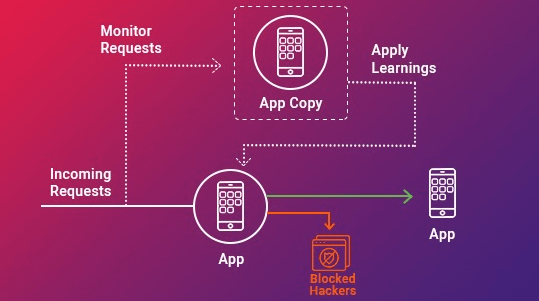A Comprehensive Overview On Runtime application self protection

RASP operates from within the application it’s designed to protect, offering a unique and effective line of defense against potential threats. Runtime Application Self-Protection (RASP) is an emerging technology that offers a new approach to application security. Its purpose is to detect and mitigate security vulnerabilities in real time, providing an extra layer of defense for applications during runtime. In today’s digital landscape, web applications are a common target for attackers. They often exploit vulnerabilities within the application’s code to gain unauthorized access or manipulate data.
How Does RASP Work?
RASP security works by integrating with the application’s runtime environment. This allows it to continuously analyze the app’s behavior and incoming traffic for signs of malicious activity. When a threat is detected, RASP can automatically take action, such as terminating a user’s session or even shutting down the application entirely.
The Benefits of RASP
RASP offers several key benefits. Firstly, it provides real-time protection, identifying and stopping attacks as they occur. Secondly, because it’s embedded within the application, RASP has an in-depth understanding of the application’s context and can make more accurate decisions about what constitutes a threat. Lastly, it can provide detailed information about attacks, including the techniques used and the specific code targeted, which can be invaluable for future security planning.
Implementing RASP
Before implementing RASP, it’s essential to conduct a thorough assessment of your application’s security needs. Consider factors such as the nature of the threats you face and the potential impact of a security breach. Once you have a clear understanding of your requirements, you can select a RASP solution that fits your needs and integrate it into your application’s runtime environment.
RASP vs. Traditional Security Measures
It’s important to understand how RASP differs from traditional security measures. Traditional security approaches, such as Web Application Firewalls (WAF) or intrusion detection systems, are situated outside of the application. They analyze incoming traffic and look for known threat patterns. While these methods can certainly be effective, they have limitations. They may not be able to detect sophisticated attacks and can sometimes generate false positives.
RASP and DevSecOps
RASP also integrates well with the DevSecOps model of software development. DevSecOps emphasizes integrating security practices into the DevOps process, encouraging collaboration between development and security teams. By automating security checks and enabling real-time threat mitigation, RASP can enhance the security aspect of the DevSecOps model, ensuring that security is given equal importance throughout the application development lifecycle. With the continual evolution of cyber threats, the need for superior application security measures like RASP will only grow. It’s a powerful tool that can offer robust protection for your applications, safeguarding your organization’s data and reputation.
Limitations and Challenges of RASP
Despite the clear benefits that RASP brings to application security, it’s important to note that it is not a silver bullet solution. Like any other security measure, it has limitations and presents certain challenges. For instance, RASP can impact application performance as it continuously monitors and analyzes all operations during runtime. The extent of this impact can vary based on the complexity of the application and the specific RASP solution implemented.
Additionally, while RASP excels at detecting and mitigating known vulnerabilities in real time, it may struggle to identify zero-day exploits or more complex, multi-stage attacks. These attacks, which exploit previously undiscovered vulnerabilities or use multiple methods in conjunction, can be particularly difficult to detect and defend against.
Moreover, effective implementation of RASP requires a deep understanding of both the application’s structure and the RASP technology itself. This can pose a challenge for organizations that lack the necessary expertise. Therefore, training and continuous learning are key components to successfully leverage RASP for application security.
The Future of RASP
As we continue to witness the rapid evolution in the cyber threat landscape, the role of RASP in application security is bound to become even more significant. Emerging technologies like artificial intelligence (AI) and machine learning (ML) are revolutionizing the capabilities of RASP, making it capable of identifying and mitigating threats with even greater precision and speed. In fact, AI-powered RASP systems are proving to be adept at identifying anomalies that might indicate complex, multi-stage attacks or zero-day exploits, thereby overcoming some of the traditional limitations of RASP.
RASP a multi-layered security strategy
Moreover, the trend towards microservices and containerized applications further emphasizes the need for effective runtime application security. With applications becoming increasingly modular, the advantages of RASP – such as its ability to operate within the application and understand its context – become even more pronounced. However, it’s crucial to remember that RASP is just one part of a multi-layered security strategy. It should be complemented by other security measures, such as secure coding practices, proactive vulnerability scanning, and adopting a security-first mindset throughout the organization.
Read also Exploring the Many Benefits of Indoor Group Cycling
RASP: A Proactive Approach to Application Security
While we’ve discussed the benefits and limitations of RASP, it’s crucial to emphasize the proactive nature of this security measure. RASP’s in-depth, real-time protection offers an active defense mechanism – a significant shift away from the reactive security measures of the past. By identifying and mitigating threats during the application’s runtime, RASP enables organizations to actively defend against attacks rather than merely responding to them after they’ve occurred.
Working With RASP Providers
Implementing RASP requires cooperation with a reliable provider. When selecting a RASP solution, organizations should consider factors such as the provider’s reputation, the scalability of their solution, their level of customer support, and the comprehensiveness of their threat detection capabilities. A dependable provider will offer robust solutions and provide expert guidance, helping organizations to navigate the complexities of application security and fully leverage the capabilities of RASP.
RASP: An Ongoing Journey
It’s important to understand that application security, and the implementation of RASP is an ongoing journey. As such, organizations need to continually monitor and update their security measures, ensuring they remain effective against the latest threats. This includes keeping abreast of advancements in RASP technology and making necessary adjustments to their application security strategies. With this ongoing commitment to security, organizations can ensure the integrity of their applications and the safety of their data.
Conclusion
Runtime Application Self-Protection is a valuable addition to the application security toolkit, offering real-time, context-aware threat detection and mitigation. While it does present certain challenges and isn’t a standalone solution, its integration with the application it protects gives it a unique advantage over traditional security measures. As cyber threats continue to evolve and proliferate, technologies like RASP will play an increasingly important role in preserving the integrity and security of digital applications. Therefore, investing in RASP, understanding its limitations, and learning how to best utilize it is crucial for organizations striving to maintain robust application security.








